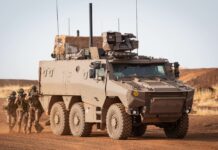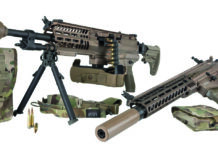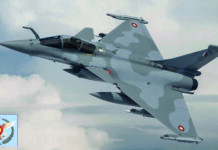If any small arms sector could be said to have benefitted from the asymmetric wars of recent years, then it would be sniping that has received far more attention than previously.
The growth in the sniping performance envelope that has resulted from a wider choice of calibres than previously, added to performance growth in optics (both day and night) has led to the realisation of how important sniping can be in both asymmetric and conventional conflicts. In parallel, there has been an increase in the mission envelope of sniper weapons, expanding from the traditional sniping role to include the anti-materiel role as well.
The Designated Marksman Rifle
That brings us to the issue of the Designated Marksman Rifle (DMR), which is another system that can be said to have found its niche in the infantry order of battle thanks to asymmetric conflicts. The majority of western ground forces are equipped with assault rifles in the 5.56×45 mm calibre. In the majority of situations that is perfectly fine. However, ground forces found themselves taking fire from outside the standard range envelope of their own weapons and later these targets were becoming harder to neutralise due to the presence of body armour. This created the need for the DMR, generally a calibre 7.62×51 mm weapon, equipped with an optic as a minimum, or a telescopic sight depending on mission. The normal range envelope is in the region of 600 to 900 metres.
The GEPARD M6
The objective here is to look at some recent developments in terms of sniping/anti-materiel weapons and at the DMR sector. Our starting point is a rather unique sniping/anti-materiel weapon from Hungary in the form of the GEPARD M6 manufactured by Sero. The story of this weapon starts in 1987 when the Hungarian military developed a requirement for a sniper rifle, but they wanted more range and lethality compared to rifle calibre sniper weapons. For this reason, they specified that the new rifle should utilise the 12.7×109 mm B-32 API round, a standard Soviet machine gun round, with a muzzle velocity of 820-860 m/s.
The weapon that resulted, the M1, was a bolt action system that was ready in 1988, after which a small number were purchased for evaluation. Development continued resulting in the M2 system. This was semi-automatic and featured a five-round box magazine. In 1991 came the M3 variant, again semi-automatic with a five-round box magazine, but this weapon used the far more powerful Soviet 14.5×114 mm round. This was followed by the M4 variant, semi-automatic and five-round box magazine, available in two calibres; 12.7×108 mm and 12.7×99 mm (.50BMG). The next M5 iteration reverted to a bolt-action configuration, but the magazine was retained as well as the dual calibre option.
All of which brings us to the sixth evolution of the design in the form of the GEPARD M6, otherwise known as the GM6 LYNX. Up to this point limited numbers of this Hungarian weapon had been sold, some for evaluation and some for operational use. The GM6 is doing far better in terms of sales. Indeed, the weapon has recently been adopted by British Special Forces and this is testimony to it being a very capable system. Quality of manufacture and engineering is high, with consistent performance improvements to the design being made which are backwards compatible for existing GM6 users.
The GM6 is described by its manufacturer as a “heavy sniper rifle,” and although it can perform the classic sniper mission, most would see it used in the anti-materiel role. As before, it is a multi-calibre weapon, either in 12.7×108 mm or 12.7×99 mm, and changing the bolt and the barrel allows the switch between calibres. Where the GM6 is different is that it is a ‘Bullpup’ configuration; this allows it have a compact shape. It is a semi-automatic weapon with long-recoil operation; the single-stack magazine contains five rounds. Empty weight is 10.5 kg, while combat weight is 13 kg. The rifle can be fitted with a suppressor. There is a wide range of scopes suitable for the GM6, including the Schmidt & Bender 12-50×56 PM II/P, Steiner M7Xi scopes are also used and versions of the weapon in the US have been seen with ELCAN SPECTER DR and Nightforce scopes. Interestingly, it appears that there have been quite a few commercial purchases of the GM6 in the US and even some in Europe. That is an awful lot of firepower for a private owner!
Meanwhile in Finland
In December 2021, the Finnish Ministry of Defence announced a contract to equip the Finnish Defence Forces with a new sniper rifle and a simplified DMR variant of the system. These new weapons will replace much of the existing TKIV 85 inventory. This is a 7.62×53 mmR (Finnish version of the old Russian 7.62×54 mmR round) calibre weapon. These were based on old Mosin Nagant bolt-action rifles that were modernised by Valmet in the mid-1980s, featuring new barrels and furniture amongst other enhancements. Also, to be replaced totally are TKIV DRAGUNOV rifles of Soviet origin, these are semi-automatic weapons in 7.62×54 mm R calibre.
In May 2020, the Finnish Defence Force signed an agreement with SAKO, under which both parties would collaborate on the development of a new sniper system initially described as the K22. Eventually this led to the development of a rifle using a modified AR operating system in 7.62×51 mm, there is a 20-round magazine, with sights and other accessories added using an M-LOK rail integration system. The weapon will be produced by SAKO in Finland.
The new rifle is available in two variants one of which is the semi-automatic sniper rifle TKIV 23. Its objective is to engage targets out to 800 metres. The weapon is fitted with the Steiner M7Xi scope and it can also be fitted with a dedicated night sight and a suppressor if so desired. The other variant is a DMR – a simplified version of the TKIV 23 designed to engage targets out to 600 metres. This system is fitted with an optic, thought to be the Trijicon VCOG (Variable Combat Optical Gunsight). Deliveries of both systems will commence at the end of this year, with system training to take place in 2023.
Finland and Sweden have signed agreements on the joint procurement of small arms and ammunition. The new Finnish sniper rifle will be the first concrete proof of this joint procurement. The Swedish Army will acquire the SAKO 23 rifle to replace its current Ak 4D sniper system, a version of the Heckler & Koch G3A3 in 7.62×51 mm. The size of the Swedish order has yet to be officially confirmed.












